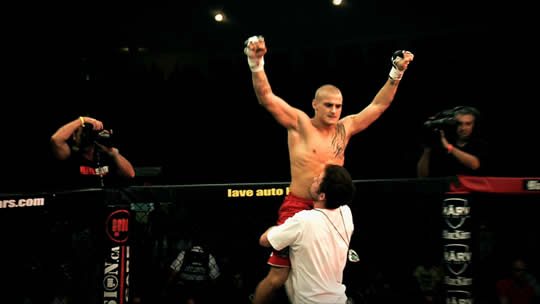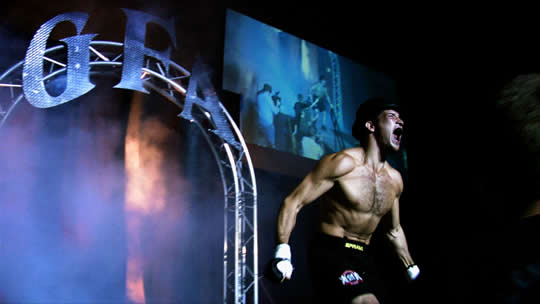 Fightville examines the world of Mixed Martial Arts (MMA), which over the past decade has grown from a controversial gladiatorial sideshow into a billion-dollar international industry. But Fightville looks beyond the spotlight of Las Vegas and focuses on the fighters, promoters and trainers who populate MMA’s not-quite-as-bright regional landscape in the American South, including current MMA powerhouse Dustin Poirier and veteran trainer “Crazy” Tim Credeur. It’s there—specifically in the local strip mall gyms and rodeo arenas of Lafayette, Louisiana—that a group of dedicated, determined young men enter caged arenas to brutally fight for a chance at glory, success, and a chance at living the American Dream.
Fightville examines the world of Mixed Martial Arts (MMA), which over the past decade has grown from a controversial gladiatorial sideshow into a billion-dollar international industry. But Fightville looks beyond the spotlight of Las Vegas and focuses on the fighters, promoters and trainers who populate MMA’s not-quite-as-bright regional landscape in the American South, including current MMA powerhouse Dustin Poirier and veteran trainer “Crazy” Tim Credeur. It’s there—specifically in the local strip mall gyms and rodeo arenas of Lafayette, Louisiana—that a group of dedicated, determined young men enter caged arenas to brutally fight for a chance at glory, success, and a chance at living the American Dream.
Fightville is directed by Petra Epperlein and Michael Tucker
Bijan Tehrani: What motivated you to make “Fightville”?
Michael Tucker: Well, the world of fighting was something that neither Petra nor I knew anything about, we fell into it by accident. I think once we were in the middle of it, we suddenly realized why so many films throughout the history of cinema had been made about the world of fighting. There are so many compelling stories, and the world of fighting is such an interesting world and it is really about overcoming yourself, about trying to be the best, and I think those sorts of things inspire people. It was just fascinating to go to that world and try to understand it. 
BT: In your film, you are not making any judgments when trying to understand the motives of the people who get involved in the world of fighting. A lot of the filmmakers start with a judgment, especially when it pertains to the violent aspect of fighting—What was your approach, with regards to your subjects and their stories?
MT: We had opinions about it and, I think—with me living around New York City and my filmmaking partner living in Germany for a long time—people have attitudes about what Mixed Martial Arts is and we were interested in really trying to understand it, as we do with any of the subjects of our films. We wanted to find out what motivates people to do this, and I think that the biggest surprise for us was that we quickly overcame the idea that it has anything to do with violence. We realized that it has to do with competition, just like any other sport and any other endeavor; we could have been following, poets, artist or anyone else, it is just about people that are focused on any one thing. It is a great thing to follow because it is so purely about that one thing, and it is so physical, it is something that you can see. Any reservations that we had, we quickly overcame.
BT: How challenging was it to make this film?
MT: Fighting was kind of interesting because, in this world of Martial Arts, people are expressing themselves with their bodies and it is often very difficult to get them to open up. So you find that balance of them capturing the performance through their body, and at the same time capturing who they are and their world view. That certainly took a while but I think, in watching them and seeing them transform through this sport and the physicality—that expresses a lot.
BT: As a filmmaker, I know it can be very hard to get people to open up and talk to you, yet in your film we see that these martial artists are very open and easily talk about their issues and weaknesses. How did you manage to pull this off?
MT: It is the same with any film, the filmmaker’s best friend is time—and you need lots of time and patience. Filming people is a lot different than filming lions in Africa; you have to be out there waiting for them, you have to be ready for when things happen, for when people respond, and try to capture those moments and performances. It is a sort of psychology that you figure out to let them know that they are making a film with you, and you are not just making a film about them. They are helping you, and it is trying to get the best out of them and understanding that this is their story and you need to share it in the best way possible. Once they understand that, they are in control a little bit and that’s when I think they really open up.
 BT: Watching your film, I could see that there is a certain artistry in some of these fighters. It’s evident that they have worked very hard to do something special in their lives.
BT: Watching your film, I could see that there is a certain artistry in some of these fighters. It’s evident that they have worked very hard to do something special in their lives.
MT: It’s funny, when we were making the film, I had read something from Malcolm Gladwell that I found interesting: he had this theory about expertise and how it takes 10,000 hours to be an expert at something. I was thinking a lot about my own life because I’m forty something years old and I spent a lot of time behind cameras and a lot of time editing, and I think that I’m getting to a point where I feel good at what I do, and I know instinctively what I am doing. I am very different than when I was twenty years old because I have put in those hours, and it was interesting to watch athletes and these fighters in the gym and seeing them put in those hours, and then watching them fight. I think the trainer said it best when he said that people watching the fights are seeing 25 minutes, but what they don’t see is the 15 years he put in to get there. So as an artist and a filmmaker, you can have the respect to say, “Wow!”. Even when you break it down into the small movements, you can see that there is real art at work there.
BT: How much time did you spend researching the film before shooting began?
MT: We did intensive reading about fighting, which is an endless topic because so much has been written about it. Not much has been written about mixed martial arts yet, but fighting is such a huge part of culture all the way back to the Greeks. Every culture has its combat sports, and that kind of gave us a lot of confidence in knowing that this sport may be every misunderstood and, given time, you are going to see this sport in the Olympics. We are just in a moment where it has not reached into maturity yet.
BT: Was there a script for the film, or was it mostly improvised?
MT: Usually we shoot, we come back, we process things, and then we look at it and we figure out what directions we want to go in. We then slowly start army editing what we have on paper, so it is sort of a combination of script writing and editing—just really honing in on where the film is going and just trying to see a blueprint of what the final film is. It was important to have it on paper and have the whole thing visualized. We learned that over the course of our filming career and we’re getting better about doing that: leaving less to chance and really knowing, through words, what it is that we want to communicate best. 
BT: Have any of the fighters seen the final film? What have their reactions been?
MT: I think that they loved it because, just like you said, I think if they are able to see themselves as artists, they are able to see that someone has taken the time to try and see their world and its great spirit. These guys have become a part of our family and that is the great thing about filmmaking, your family does grow, and we have this huge family all around the world of all of these different characters. Everyone in the film has a story that they want to tell, so it is an honor to help share their stories.
BT: Do you think those who oppose these kinds of violent sports might change their minds after watching the film?
MT: Absolutely. I think that some people will always be against it because they can’t open up their mind, but I once people see the fighters as people—once they get to know them and see what motivated them—they see that it is not about violence, but about competition and spirit. For many, it is about this urge just to be the best, and it is the same thing that drives all of us. A lot of unsuspecting people have walked out of these screenings with an experience they would have never expected. Audiences have been inspired by seeing these fighters devote themselves to something. For me, that is the message in the film: what does it take to be the best at anything?
BT: Any new documentaries lined up?
MT: Right now I’m just trying to get this film out, though I certainly have a few ideas. Whatever comes next will certainly be different from this one, I am sure.
Fightville’s Los Angeles Release Date: April 20, 2012 at Laemmle’s Music Hall 3 in Beverly Hills. Fightville opens on the same date in New York.

